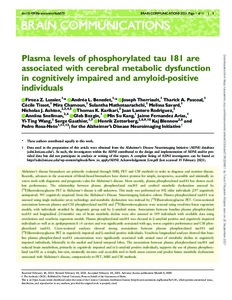Plasma levels of phosphorylated tau 181 are associated with cerebral metabolic dysfunction in cognitively impaired and amyloid-positive individuals
Lussier Firoza Z; Benedet Andréa L; Therriault Joseph; Pascoal Tharick A; Tissot Cécile; Chamoun Mira; Mathotaarachchi Sulantha; Savard Melissa; Ashton Nicholas J; Karikari Thomas K; Rodriguez Juan Lantero; Snellman Anniina; Bezgin Gleb; Kang Min Su; Fernandez Arias Jaime; Wang Yi-Ting; Gauthier Serge; Zetterberg Henrik; Blennow Kaj; Rosa-Neto Pedro; Alzheimer’s Disease Neuroimaging Initiative
https://urn.fi/URN:NBN:fi-fe2021093048780
Tiivistelmä
Alzheimer's disease biomarkers are primarily evaluated through MRI, PET and CSF methods in order to diagnose and monitor disease. Recently, advances in the assessment of blood-based biomarkers have shown promise for simple, inexpensive, accessible and minimally invasive tools with diagnostic and prognostic value for Alzheimer's disease. Most recently, plasma phosphorylated tau181 has shown excellent performance. The relationship between plasma phosphorylated tau181 and cerebral metabolic dysfunction assessed by [18F]fluorodeoxyglucose PET in Alzheimer's disease is still unknown. This study was performed on 892 older individuals (297 cognitively unimpaired; 595 cognitively impaired) from the Alzheimer's Disease Neuroimaging Initiative cohort. Plasma phosphorylated tau181 was assessed using single molecular array technology and metabolic dysfunction was indexed by [18F]fluorodeoxyglucose PET. Cross-sectional associations between plasma and CSF phosphorylated tau181 and [18F]fluorodeoxyglucose were assessed using voxelwise linear regression models, with individuals stratified by diagnostic group and by β-amyloid status. Associations between baseline plasma phosphorylated tau181 and longitudinal (24 months) rate of brain metabolic decline were also assessed in 389 individuals with available data using correlations and voxelwise regression models. Plasma phosphorylated tau181 was elevated in β-amyloid positive and cognitively impaired individuals as well as in apolipoprotein E ε4 carriers and was significantly associated with age, worse cognitive performance and CSF phosphorylated tau181. Cross-sectional analyses showed strong associations between plasma phosphorylated tau181 and [18F]fluorodeoxyglucose PET in cognitively impaired and β-amyloid positive individuals. Voxelwise longitudinal analyses showed that baseline plasma phosphorylated tau181 concentrations were significantly associated with annual rates of metabolic decline in cognitively impaired individuals, bilaterally in the medial and lateral temporal lobes. The associations between plasma phosphorylated tau181 and reduced brain metabolism, primarily in cognitively impaired and in β-amyloid positive individuals, supports the use of plasma phosphorylated tau181 as a simple, low-cost, minimally invasive and accessible tool to both assess current and predict future metabolic dysfunction associated with Alzheimer's disease, comparatively to PET, MRI and CSF methods.
Kokoelmat
- Rinnakkaistallenteet [27094]
